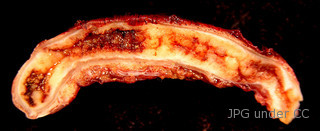What is ruptured appendicitis
It important to know the major ruptured appendicitis symptoms to recognize this disease early. The appendix is a small and worm-like appendage that is attached to the cecum – the beginning of the large intestine or colon.
This organ has no specific function, but it can get infected. There are many conditions that affect the appendix that you should be aware of.
It gets blocked with stool or by bacteria, and this can lead to production of mucus, which will eventually thicken and block the appendix leading to inflammation and swelling that may lead to the condition known as appendicitis.
This disease is a medical emergency that when left uncured for may lead to rupture of this organ in the human body and even severe and fatal infection. The rupture of the appendix is widely known to affect children and young adults.
Ruptured appendicitis in children is highest among males at the age of 10 to 14 years and in females aged 15 to 19. It affects more males than females between puberty and those in the 25 years of age bracket. Notably, it is low and rare in the elderly and in children under the age of two years.
Common symptoms of appendix rupture
It really important to know ruptured appendix symptoms. However, the widely experienced and indeed the first symptoms are on and off pain on the right side of the abdomen. This pain will in most cases gradually increase to a sharp and unrelenting pain that will be felt in and around the bellybutton.
Additionally, patients of appendicitis will also talk of pain around the lower quadrant of the abdomen, which becomes more painful when you walk, take a deep breath, cough or sneeze. Other symptoms of appendix problems include fever, diarrhea, constipation, nausea, vomiting and loss of appetite among others.
There are many complications of appendicitis that are associated with this condition. The most common one is a blockage of the intestine. When the appendix gets blocked and inflamed, there is no easy passage of liquids or gas, and this may lead to nausea and vomiting.
Additionally, this blockage also affects the functioning of the intestinal wall making it hard for the body to digest food within a short duration. An appendix rupture typically occurs within 24 hours of noticing the symptoms. Therefore, you need to know how to diagnose a rupture of the appendix within the shortest time possible.
Careful examination is important when diagnosing a burst appendix. One also needs to provide his medical historical background for easy treatment. Even if caught early, one of the most recommended treatments for appendicitis is surgery to remove the appendix.
Here, the main goal is always to remove the appendix before it ruptures and spreads the infection to other parts of the body such as the abdomen or peritonitis. There are two possible ways the appendicitis surgery can be performed, either through laparoscopic or the traditional method. However, antibiotics treatment is not such effective as Appendectomy.
If you require this treatment, make sure you visit your doctor for early care. Early prognosis will assist in a quicker ruptured appendicitis recovery time.


Leave a Reply